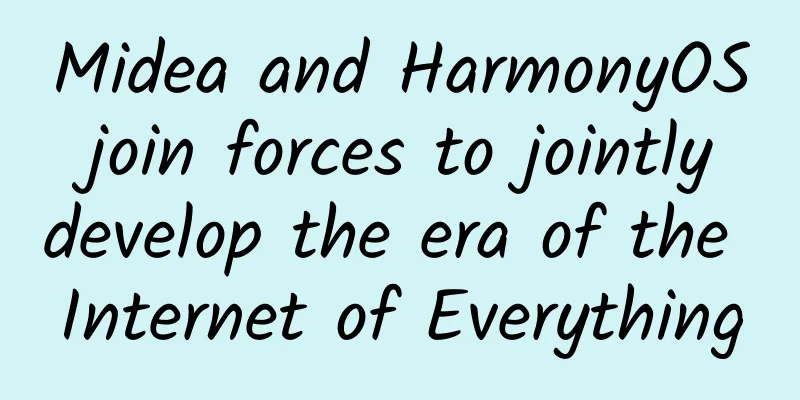Midea and HarmonyOS join forces to jointly develop the era of the Internet of Everything

|
[51CTO.com original article] On September 10, 2020, at the Huawei Developer Conference 2020, Huawei Executive Director and Consumer Business CEO Richard Yu officially released the HarmonyOS 2.0 version and announced the first batch of important partners in China to join the HarmonyOS ecosystem. Midea Group was on the list. As a pioneer in the domestic HarmonyOS ecosystem, Midea Group launched more than a dozen home appliances equipped with the HarmonyOS system on Double 11 this year, including water purifiers, water heaters, dishwashers, steam ovens and other home appliances. It is also the company with the largest number of home appliances launched in the HarmonyOS ecosystem. So why did Midea Group choose to be the first to join the HarmonyOS ecosystem? What business value can the launch of so many home appliances equipped with the HarmonyOS system bring? What exactly is the goal of Midea's cooperation with HarmonyOS? Dr. Chen Ting, Midea's IoT smart connection expert, was interviewed not long ago and shared the strategic thinking and innovative exploration behind Midea's cooperation with HarmonyOS. Midea and HarmonyOS hit it off in IoT collaboration Chen Ting admitted that the biggest driving force for choosing to cooperate with HarmonyOS was that Midea Group’s development strategy in the era of the Internet of Everything was highly consistent with HarmonyOS’s service support capabilities. He revealed that the commercial use of 5G has accelerated the arrival of the era of the Internet of Everything, and consumers have put forward higher requirements for the experience of the Internet of Everything across categories, industries, and technologies. Midea realizes that smart home companies must have the ability to horizontally integrate resources in the home service industry chain, realize the interconnection of more devices and services, and create an open and win-win smart ecosystem. The emergence of HarmonyOS is undoubtedly a "god assist" for the future development of Midea's IoT. It not only allows more terminal devices to connect to each other and break the limitations of the hardware capabilities of a single physical device, but also enables complementary capabilities and performance enhancement between different hardware. "HarmonyOS has the characteristics of distributed, multi-terminal deployment, security, and easy development. All of these are key to the development of the Internet of Things in the 5G era. Therefore, it is natural that it has become the best choice for Midea's IoT to practice the concept of 'understanding your smart life'." In July 2020, Midea and Huawei jointly announced that they had become strategic partners to create a full-scenario smart life experience for consumers. For the HarmonyOS cooperation, the two parties established a joint project team for joint research and co-creation. At the Huawei Developer Conference 2020 in September, Midea and Huawei jointly created a Midea brand smart kitchen area, where household air conditioners, water purifiers, steam ovens and other categories equipped with the HarmonyOS system were the first in the industry, attracting many participants to come and experience it. In addition, Midea and the HarmonyOS team have invested a lot of energy to jointly create a set of efficient smart home appliance development processes. In the future, smart home appliance developers can use this set of processes to quickly develop and implement smart home appliance products equipped with HarmonyOS, and jointly promote the upgrading of the smart home industry. Bringing a brand-new control experience, HarmonyOS creates a win-win situation for Midea and consumers So when Midea's devices are connected to HarmonyOS, what new experiences do they bring to consumers? And what commercial value does it create for Midea?
Chen Ting said that the "touch and pay" function may be the most surprising control function for consumers. In terms of terminal hardware, consumers can quickly discover the connectable Midea smart devices based on HarmonyOS through Huawei phones equipped with EMUI11. A touch can achieve fast network configuration in 3 seconds without downloading applications, which greatly simplifies the network configuration method, and the network configuration success rate is close to 100%. In terms of interactive experience, users can enter the Midea smart home appliance control page through multiple entrances. In addition to network configuration and control of Midea smart home appliances by touch, they can also control them by voice. In terms of user services, Midea and Huawei jointly create a ubiquitous full-cycle service experience for users. For example, when consumers use Midea's smart rice cooker equipped with HarmonyOS to cook rice, Huawei phones or smart watches will send messages to remind users that the rice has been cooked; when the filter element of Midea's smart water purifier needs to be replaced, users will also receive reminders from Huawei phones equipped with EMUI11. From the purchase of consumables to after-sales service, everything can be done on mobile phones equipped with EMUI11. "There is no doubt that HarmonyOS has improved the networking speed of Midea's IoT devices to a certain extent. Currently, due to network problems in the user's environment, the networking time is relatively long. After home appliances are equipped with HarmonyOS, the connection process can be reduced to 3s. This allows Midea's IoT devices to have a differentiated experience and is far ahead of similar competing products." Chen Ting said. What makes HarmonyOS different? Professionals engaged in home appliance research and development are well aware that the product development cycle of home appliances is relatively long. However, in Midea's HarmonyOS project, the two parties' rapid development speed, from the project launch in July to the product launch and supply for Double Eleven in November, can be said to have created a miracle in the industry. This is inseparable from the attention of the Midea team and the support and help from the Huawei HarmonyOS team. According to Chen Ting, Midea Group and its various business units attach great importance to the HarmonyOS project, including the R&D of the seven major product business units, product marketing personnel and relevant personnel of the IoT business unit, all of whom have invested a lot of work. In addition, throughout the project process, Huawei HarmonyOS team colleagues provided Midea with full technical support in all aspects from R&D, testing to product certification. After the establishment of the joint project team, the core members of the HarmonyOS project team were directly stationed in Midea's office for on-site support for special product development. All of these provide strong guarantees for Midea's products equipped with HarmonyOS to be successfully and on time launched on the market. The rapid progress of Midea's HarmonyOS project also proves the ease of use of the HarmonyOS system from another perspective, making it easier to integrate into home appliances. For example, the development tool platform HUAWEI DevEco provides a one-stop integrated development environment that supports on-demand customization of HarmonyOS components, one-click compilation and burning, visual debugging, distributed capability integration and other operations, greatly improving development efficiency. In the process of using HarmonyOS for product innovation, Chen Ting also clearly felt the difference between the HarmonyOS system and other IoT OS platforms: For consumers, HarmonyOS provides the ultimate next-generation connection experience. For example, the one-touch "no-touch network configuration" can quickly simplify network configuration, and directly call services without installing and frequently clicking apps. For developers, the HarmonyOS system has a componentized and lightweight design, fully optimized in terms of performance and hardware power consumption, greatly reducing the development threshold and making it easy for device developers to integrate into the HarmonyOS ecosystem; For device manufacturers, there is no need to communicate with other device manufacturers one by one to provide services, because based on the same HarmonyOS system, everyone has a consistent experience and a consistent development framework. Device manufacturers can form a super terminal under the HarmonyOS system, share their respective capabilities, and create a better life experience for consumers. In Chen Ting's view, HarmonyOS is an epoch-making and innovative operating system that not only solves the problem of IoT ecosystem fragmentation, but also provides equipment manufacturers and service providers with a single platform to provide consumers with consistent services, so that people no longer need to install dozens of apps to enjoy smart life, and no longer need to manually set up device linkages one by one, truly presenting people with a smart living environment. "HarmonyOS is worth looking forward to, and even more worth participating in." [51CTO original article, please indicate the original author and source as 51CTO.com when reprinting on partner sites] |
<<: Liu Duo from CAICT: There are 32,000 5G base stations used in the industrial Internet
Recommend
eSIM is making a big splash in the IoT space, but it’s not yet seen on mobile phones
Recently, Beijing Mobile officially launched the ...
Division of wireless AP channels in WLAN
What is a channel? Channel is commonly referred t...
MQTT protocol, someone finally explained it clearly
[[409407]] This article is reprinted from the WeC...
ICMP/ARP protocol analysis and ARP spoofing
ICMP ICMP (Internet Control Message Protocol) is ...
Servmix: $1.03/first month - single core, 1G memory, 30G SSD, 1TB monthly traffic, German VPS
Servmix is a foreign hosting company founded in...
80VPS: Hong Kong CN2 server monthly payment of 600 yuan, E5-26**V2/16GB/1TB or 600G*2/20M bandwidth, optional CN2 high defense
80VPS is a long-established Chinese hosting compa...
How to start learning socket programming for beginners
Sockets are endpoints for communication between n...
Hundreds of unicorns died in 2019: 3 reasons, 5 traps, and a mess
2019 can be called the year of naked swimming for...
Foreign media: The joint development plan of RCS by the three major US telecom operators has failed
[[393243]] According to a report from Light Readi...
Feiyuxing Wireless helps the famous Yueyang No. 16 Middle School realize campus informatization construction
The 16th Middle School of Yueyang City, Hunan Pro...
Megalayer: Starting from 24 yuan/month-1GB/50G SSD/10M CN2/San Jose & Hong Kong & Singapore data centers
Megalayer is a foreign hosting company registered...
China's commercial Wi-Fi market size exceeds 4.1 billion yuan, analysis of the three major development trends of the industry
Commercial Wi-Fi is a wireless Internet service p...
Let’s talk about the Vrrp protocol?
[[374759]] This article is reprinted from the WeC...
Misaka: $44/year KVM-2GB/32G NVMe/2TB/Germany (optional CN2)
Misaka is a Chinese merchant (the same company as...
Yecao Cloud's New Year's Big Offer: Hong Kong VPS annual payment starts from 138 yuan, Hong Kong dedicated server starts from 299 yuan/month
Yecaoyun has announced a huge discount event for ...









